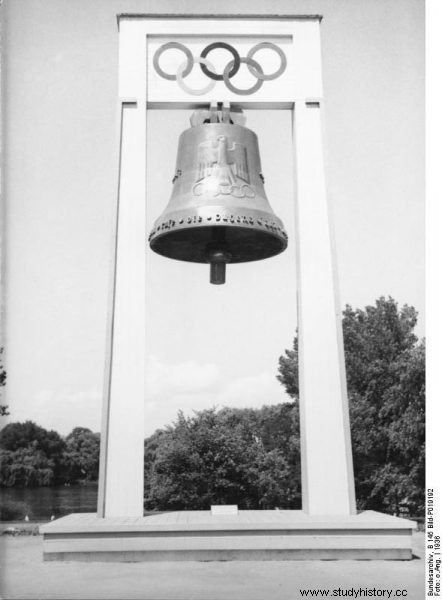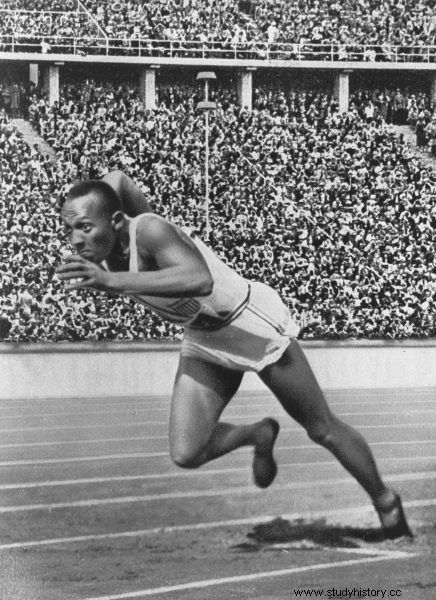The Olympic Games held in Berlin in 1936 are the most controversial sports competition in the history of the 20th century and at the same time an excellent propaganda tool that was skillfully used by the Führer.
The Summer Olympic Games in the capital of the Third Reich were held only three years before the Second World War, between August 1 and 16, 1936. This event was attended by the largest number of foreigners in Berlin's history. Germany hosted many eminent personalities, such as the Bulgarian Tsar Boris, the Italian Crown Prince Humbert and the Swedish prince Gustav Adolf. Exquisite celebrations awaited the famous and influential of this world every day, also organized by Hitler's most important associates - Hermann Göring, Joseph Goebbels and Joachim von Ribbentrop.
Immediately after the opening ceremony, the head of the American Olympic Committee, Avery Brundage, praised the Berlin Games with great enthusiasm:
Since ancient Greece, no nation has expressed its true Olympic spirit as Germany has.

The bell from the Olympic Games in Berlin contains the Olympic symbol with the German eagle and the inscription:"I call the youth of the world!"
The delight of American athletes
The American players came to the Olympics on the luxury liner of the SS "Manhattan". The joyful Germans standing on the shore cheered for the guests from the USA . A water polo player commented on the situation as follows:
I have never seen anything so beautiful in my life. As long as I'm alive, I won't forget this sight.
Americans in Berlin met with a warm welcome at every step, and the inhabitants of the capital accompanied them in large numbers throughout their stay. Herbert Wildman recalled:
The crowd followed us step by step and followed our every move. Hardly anyone spoke English, but when we laughed they chimed in.
Olympic Village
The athletes were very impressed with the leisure infrastructure prepared especially for all male national teams, for example the Finns built a sauna, and the gastronomic one, where the rich and wide menu allowed to satisfy the appetite of each participant of the Olympics, regardless of their origin or religion. Everything was tidy and impeccably clean.
However, the players were treated much worse in terms of sleeping places, because they were provided with Spartan conditions in the form of hard beds and an unsophisticated menu.

Berlin Olympic Stadium (1936)
Road through Germany
The Nazis skillfully kept foreign visitors away from the real face of their country. Nevertheless, some athletes discovered fragmentarily the true picture of Nazi Germany . Herbert Wildman, despite his admiration for the organization of the Olympic Games, witnessed how several-year-old children played in dirty and cold water, and learned that rails located on the roofs of buses carrying athletes are needed to mount machine guns and how easy it is to modify the harmless and still flying overhead gliders:
From what we understood, it was enough to detach the prow [of the glider] and attach the engine to make it a combat plane.
The trip through the Third Reich for an efficient observer also provided a lot of important information about the actual situation. Everywhere large groups of uniformed people met , there were young and armed people in the forests. American gymnast Keeneth Griffin stated that it gave the disturbing impression that the Germans were really getting ready for war.
The dark skinned masters from Berlin
American dark-skinned athlete, four-time gold medalist from Berlin, Jesse Owens could not count on congratulations from Adolf Hitler, but the German fans made a huge surprise by cheering for Owens. Another black Olympian who won gold in the 800-meter race, John Youie Woodruff, had the same reaction. He argued that he had not faced any discrimination and that the fans around him asked for an autograph. Woodruff himself recalled years later, driving a pin on the policy discriminating against black citizens in the USA:
(...) I did not meet any loathsome Nazis, only nice Germans. And I didn't have to go in the back of the bus.
The American of Jewish origin Marty Glickman referred to the Berlin experience in a similar vein:
I haven't seen or heard anything anti-Semitic except for the day I was supposed to run the preliminaries. It was the first and only display of anti-Semitism that I had experienced. And I experienced it from the American coaches, not the hosts.

Jesse Owens, American athlete, multiple world record holder
and four-time Olympic champion from Berlin
When the lights go out
Most of the Olympics participants left after the Berlin Olympics were closed, but those who decided to extend their stay in Germany saw their eyes. One of these players was an American baseball player of Lithuanian origin, Frank J. Lubin. He discovered that Jewish restaurants must be marked with the Star of David, and public swimming pools are not allowed for Jews.
Philip Cook, Bishop of the Delaware Reformed Episcopal Church said on his return to the US:
Germany is a great place for an American tourist. If you follow their customs and do what they tell you, [it] will give you the best care.

Success of the führer
After the Olympics, everything returned to "normal" in Nazi Germany, and Adolf Hitler could be satisfied with the propaganda campaign carried out. The media around the world wrote with the hope for a better tomorrow and a change in the policy of the Third Reich under the influence of the just ended sports festival . In the British Evening Post they wrote:
Undoubtedly, the Germans realized their intention to enchant the guests, although everyone was surprised by the impression that the guests had on the hosts, who had been taught to be suspicious of foreigners for three years, and therefore at first greeted them politely, but with reserve. When the first ice was broken, the guests aroused only great cordiality in them.
Bibliography:
- J. Boyd, Vacation in the Third Reich. The birth of fascism through the eyes of ordinary people, Wydawnictwo Prószyński i S-ka 2019.
- New York Times, July 25, 1936
- Herbert A. Wildman, interview with G.A. Hodak, October 1987
- Kenneth P. Griffin, interview with G.A. Hodak, August 1988
- San Francisco Chronicle, June 12, 1984
- Marty Glickman, interview, 1966
- Brooklyn Daily Eagle, September 15, 1936
- New York Times, September 16, 1936
- Evening Post, vol. CXXII, ed. 34, August 8, 1936
